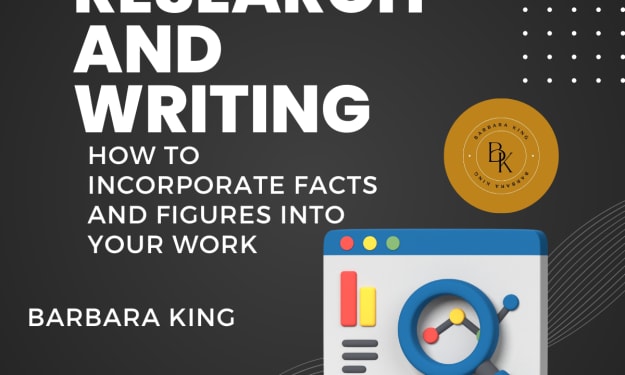Using Metaphors and Similes
Techniques for Adding Depth and Meaning to Your Writing

It's almost impossible to escape similes and metaphors since they surround us. Not just in literature, but in advertisements and music as well. Pat Benatar knew all about it when she said "Love is a battlefield."
Sure you probably haven't thought about the exact use of similes and metaphors since that grammar test you took long ago in high school or even further back in middle school, but similes and metaphors are powerful literary devices that will help you convey thoughts and emotions to your reader in an impactful way.
Writing is a puzzle, and each word is a piece that fits snugly into place, creating a picture that delights the mind. ← Metaphor
Before you learn how to use these literary devices let's once again bring you back to a time of wooden desks, chalkboards, or dry-erase boards if you were lucky enough to escape the never-ending cloud of dust, and let's take a quick refresher course.
Understanding Metaphors and Similes
Your reader isn't going to shift through your book and pick out the similes and metaphors unless you are lucky enough to get the Shakespeare treatment and have your work dissected and examined by students who are thinking more about lunch than how well the author compared the black curtains to the burnt embers of hell. So knowing the difference isn't all too important, but it'll help you out when it's time to use them to know what they are and what they do.
Defining Metaphors and Similes
A metaphor takes two things that are unrelated to each other and states that one thing is another
A simile takes two things and tries to show you how they are connected using "like" or "as" to point it out to you.
Impact of Metaphors and Similes in Storytelling
- Enhance Imagery
Sure you could just say that "the moon was bright", but wouldn't it sound better if that moon was like something else, such as "like a radiant lantern, casting its soft light upon the village below?"
- Evoke Emotions
Metaphors and similes give you the opportunity to bring out the reader's emotions by expanding on those of your character. For example, if your character is angry at a betrayal, give it some description such as, "a beast raged within her, tearing and scratching at the walls of her heart demanding to be set loose."
- Deepen Meaning
If you've been anywhere around anything you'll know the phrase to rise like a phoenix from the ashes. Doesn't this give it a bit more meaning than simply saying they got back up when they were knocked down? Sounds more like the resistance to adversity than a tiff in the schoolyard.
Techniques for Using Metaphors and Similes in Your Novel
Now that you know what we're working with, let's find out how to work with it.
Sensory Details
You want to put your reader into your story in any way that you can, you don't want them to just know that the smell of freshly baked bread is in the air, you want the smell to envelop them like a warm embrace.
You want to hear her laughter dancing in the room, filling it with the sounds of ringing bells.
You want her touch to be as gentle as a feather, tracing delicate patterns on your skin.
Give your reader a vivid sensory experience. Don't just let them read it, let them feel, see, taste, and smell it.
Show, Don't Tell
Put down that book, it'll do more damage to your screen than it'll do to me.
I know you're sick of this one, but I'm going to continue to repeat it until I can't type anymore and then I'll probably learn to type with chopsticks in my teeth just so you don't forget it.
Never tell your reader what you should be showing them, especially with emotions. She was angry. She was scared. She was heartbroken.
Make her angry like a storm brewing on the horizon.
Show her in love, as gently as a whisper in the wind.
Break her heart, her emotions shattered like fragile glass and he was the careless hand.
Give your readers something to see in your character's emotions, sure it's all just words, but so is poetry and it can bring some of the biggest grown men to tears.
Balance Creativity and Clarity
It's the age-old adage that you can in fact have too much of a good thing.
"The sun rose in the sky, a radiant golden orb that cast its warm embrace over the world. Its rays were like delicate fingers, reaching out to caress the earth and awaken its slumbering inhabitants. The flowers, like colorful jewels, nodded their heads in gratitude, basking in the sun's loving gaze. The breeze, a gentle whispering lover, danced through the trees, playing a melodic symphony with their swaying branches. The river flowed like a silver ribbon, its currents shimmering and sparkling in the sunlight."
At some point, your reader is going to start wondering when the story is going to start especially if this continued any longer. Sure if I was writing poetry this would fit right in, or if this was fiction written years ago sure, but today's readers don't want waxing poetics in their fiction, they want you to get to the good stuff.
You want to enhance your narrative, not bury it under pretty words.
____________________________________________________
Writing metaphors and similes come naturally to some writers and for others, it'll take a bit of practice to remember to include them every once in a while or to not overdo it, but this is what editing is for.
Now get to writing.
With love,
BK. xo xo
____________________________________________________
*If you've liked what you read you can show your support by subscribing, pledging your support, or leaving me a tip that directly supports and aids me as a writer.
By joining Vocal+ you can earn more per read on every story you publish on Vocal.
Click my link to start your 7-day free trial today and start earning more for your stories.
_____________________________________________
This story was originally posted on Medium.
If you would like to experience Medium yourself, consider supporting me and thousands of other writers by signing up for a membership. It only costs $5 per month, it supports us writers, greatly, and you have the chance to make money with your own writing as well. By signing up with this link, you'll support me directly with a portion of your fee, it won't cost you more. If you do so, thank you a million times!
If you love what you've read you can also show your support by buying me a cup of coffee to fuel my writing.
About the Creator
Barbara King
Barbara King is a full-time writing coach and novelist. King is a recent college graduate from Southern New Hampshire University where she earned her BA in Creative Writing.
Reader insights
Outstanding
Excellent work. Looking forward to reading more!
Top insights
Compelling and original writing
Creative use of language & vocab
Easy to read and follow
Well-structured & engaging content
Excellent storytelling
Original narrative & well developed characters
Expert insights and opinions
Arguments were carefully researched and presented
Eye opening
Niche topic & fresh perspectives
Heartfelt and relatable
The story invoked strong personal emotions
On-point and relevant
Writing reflected the title & theme






Comments
There are no comments for this story
Be the first to respond and start the conversation.